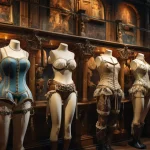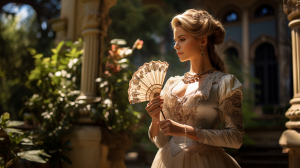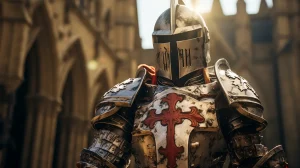
A Journey Through Time: Knightly Attire Unveiled
Ladies and gentlemen, fashion enthusiasts, and history buffs alike, prepare to embark on an extraordinary voyage through the annals of time—a voyage that will transport you to an era of chivalry, valor, and the iconic armor that adorned the knights of old. FashionTimeWarp welcomes you to a captivating exploration of “Knightly Attire: Armor, Chainmail, and Chivalry in Medieval Fashion.” 🏰✨
In the heart of the medieval world, where honor and duty were sacred, where gallant knights rode forth to uphold the ideals of chivalry, a remarkable fusion of artistry and practicality emerged. Medieval knight armor, often forged in the fires of dedication and crafted with meticulous care, was not merely protective equipment—it was a symbol of honor, valor, and an enduring legacy.
Join us as we peel back the layers of history, revealing the evolution, craftsmanship, and cultural significance of these awe-inspiring suits of armor. Together, we will journey through time to understand how these iconic pieces of clothing shaped not only the knights who wore them but the very essence of an age marked by chivalry and noble ideals. 🛡️🪙
In the pages that follow, you will witness the evolution of knightly attire, from its humble beginnings in the early medieval period to the exquisite plate armor that became the hallmark of knighthood. We will delve into the components of knightly attire, exploring the intricate details of plate armor, the interlocking rings of chainmail, and the imposing visages of helmets and visors. 🗡️🩸
But armor was not merely a tool of war; it was a canvas upon which knights painted their codes of honor and beliefs. Discover how these warriors of yore viewed their armor as not just protection but as a tangible representation of their unwavering commitment to chivalric virtues. 🌟
Venture with us into the practical realm of armor, where we’ll explore its role in battle and its everyday wear. We’ll take you on a journey across Europe, uncovering regional variations and the distinctive armor of knightly orders. And as we conclude, we’ll unravel the enduring legacy of medieval knight armor, showcasing its influence on modern fashion and its place in our cultural imagination. 🌍🛡️
As you read on, picture the gleaming armor, the clash of swords, and the chivalrous spirit of a bygone era. Imagine knights in shining armor, not as mere figures from history, but as living symbols of honor and courage. Welcome to a world where fashion transcended mere clothing—it became a testament to the virtues of knighthood. 🪶🐎
The Medieval Knight: A Symbol of Chivalry
As we step further into the medieval world, it’s essential to understand the central figure around which our journey revolves—the medieval knight. Knights were more than just warriors in shining armor; they embodied a code of conduct known as chivalry, a set of values that defined their character and actions. In this section, we’ll explore the concept of chivalry and how it shaped the lives of these noble figures.
Chivalry: The Heart of a Knight’s Identity
Chivalry was more than a word in the medieval lexicon; it was a way of life. Knights were not merely skilled fighters, but they were also expected to uphold a strict code of ethics and honor. This code of chivalry encompassed virtues such as loyalty, courage, honesty, and respect for authority. Knights vowed to protect the weak, serve their lords with unwavering devotion, and champion justice in all their endeavors.
The Chivalric Oath
At the core of a knight’s commitment to chivalry was the chivalric oath. Knights swore solemn vows that bound them to the principles of honor and virtue. These oaths were not mere formalities; they were deeply meaningful and set the moral compass by which knights navigated their lives.
The Ideal of Courtly Love
Chivalry wasn’t limited to battlefield valor; it extended to the realm of romance. Knights were expected to be not just fierce warriors but also courteous and gallant in their interactions with women. The concept of courtly love emerged, emphasizing devotion, admiration, and respect for the ladies of the court.
Knightly Attire: An Emblem of Chivalry
Now, let’s bring our focus back to knightly attire. Armor, which we will delve into further, was more than a protective shell—it was a tangible symbol of a knight’s commitment to chivalry. The gleaming armor, resplendent with heraldic symbols, bore witness to a knight’s unwavering adherence to the code.
Heraldic Symbols on Armor
Knights often adorned their armor with distinctive heraldic symbols, known as “coat of arms.” These symbols represented their families, allegiances, and achievements. Each element of a knight’s coat of arms had a specific meaning, creating a visual language that communicated their identity and values.
Armor Etiquette and Behavior
In the world of chivalry, how a knight wore and carried themselves in armor mattered greatly. There were specific etiquettes related to donning and removing armor, as well as protocols for behavior both on and off the battlefield. These rules reinforced the idea that a knight’s identity was inseparable from their armor.
Chivalry in Combat
In battle, knights demonstrated their commitment to chivalry through their actions. They were expected to show mercy to fallen foes, protect non-combatants, and conduct themselves with courage and honor, even in the face of danger. Armor played a vital role in safeguarding a knight’s life, allowing them to continue their service and uphold their vows.
In this section, we’ve begun to unravel the complex world of chivalry and its profound influence on knights and their attire. As we continue our journey, we’ll delve deeper into the evolution of medieval armor, exploring the intricate craftsmanship that went into creating these magnificent suits of protection and honor.
Evolution of Medieval Armor
Welcome to a captivating journey into the very heart of medieval fashion—an exploration of how knightly attire transformed and adapted over time. In this section, we’ll traverse the chronological landscape of armor evolution, unearthing the fascinating transitions from its early origins to the pinnacle of knightly protection.
Early Medieval Armor: Foundations of Fortitude
Our voyage begins in the early medieval period, a time when armor was rudimentary but nonetheless crucial for the safety of knights. These brave warriors ventured onto battlefields, clad in armor that marked the dawn of a new era in personal protection.
Leather and Lamellar Armor
Early medieval armor comprised layers of leather and small iron plates known as “lamellae.” Leather provided a degree of flexibility, while lamellae added strength. This armor was vital for protection but lacked the intricate craftsmanship of later eras.
Helmets of Simplicity
Early medieval helmets were often simple in design, consisting of a dome-shaped iron cap with minimal facial protection. While they offered some defense, they were a far cry from the elaborate visages we associate with knights.
Transitional Armor: The Bridge to Brilliance
As time marched on, so did the evolution of knightly attire. The transitional period witnessed significant advancements in armor design, setting the stage for the iconic suits of plate armor that would follow.
Chainmail: A Step Forward
Chainmail, characterized by interlocking rings, emerged as a game-changer. It provided greater flexibility and coverage, offering knights improved protection while allowing for more agile movements on the battlefield. Chainmail was a significant leap forward in the evolution of armor.
The Rise of Plate Armor
The transition from mail to plate armor marked a pivotal moment in medieval fashion. Plate armor, consisting of articulated metal plates, offered superior protection and was crafted with meticulous attention to detail. This heralded the era of knights in gleaming suits of steel, their armor intricately designed to maximize both protection and mobility.
Plate Armor: The Epitome of Knightly Protection
Our journey through the evolution of medieval armor culminates in the exquisite plate armor that became the hallmark of knighthood. These masterpieces of craftsmanship not only shielded knights from harm but also elevated their status to legendary proportions.
The Components of Plate Armor
Plate armor was a symphony of individual components, each meticulously crafted for specific purposes. We’ll delve into the breastplates, gauntlets, greaves, and other elements that composed these formidable suits.
Innovations in Plate Armor Design
As knights encountered new challenges on the battlefield, armor design continued to evolve. Innovations such as articulated joints, fluting, and decorative embellishments not only enhanced protection but also added an aesthetic dimension to knightly attire.
In this section, we’ve embarked on a journey through the annals of armor evolution, witnessing the transition from humble beginnings to the magnificent plate armor of the medieval era. As we continue our exploration, we’ll delve into the intricate components of knightly attire and uncover the artistry behind their creation.
The Components of Knightly Attire
In our ongoing exploration of knightly attire, we now turn our attention to the intricate components that together composed the formidable suits of armor donned by medieval knights. These suits were not mere garments; they were marvels of craftsmanship, each piece serving a specific purpose in ensuring both protection and mobility.
Breastplate: Fortress of the Torso
At the heart of a knight’s armor lay the breastplate—a formidable piece that shielded the most vulnerable area, the torso. Crafted with precision, the breastplate was designed to absorb and deflect the impact of weapons, safeguarding the knight’s vital organs.
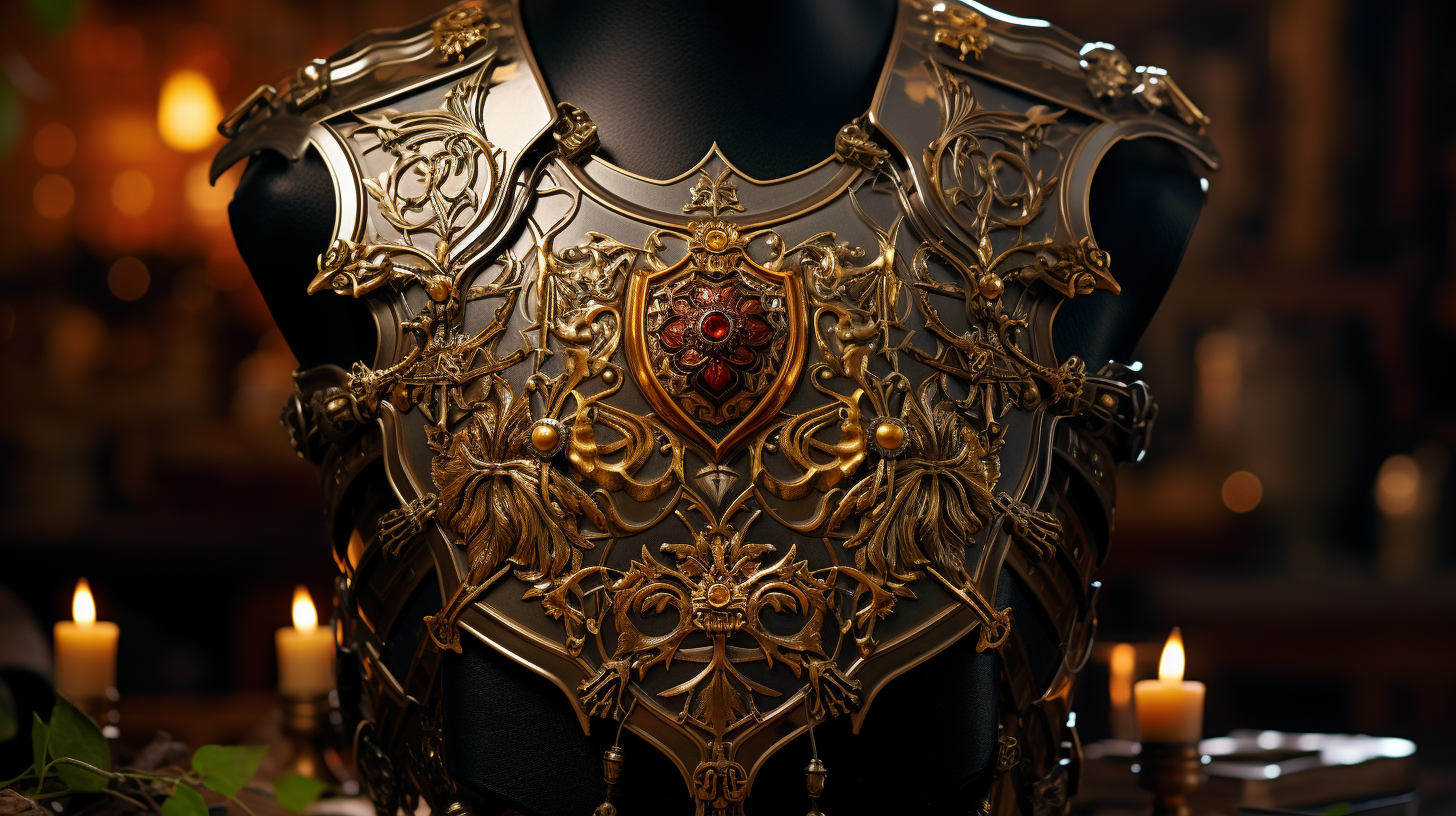
Image: Imagine a beautifully crafted breastplate, adorned with intricate patterns and heraldic symbols, glistening under the sunlight.
Articulated Joints
To ensure knights could move freely, the breastplate featured articulated joints. These hinged or riveted sections allowed flexibility while maintaining a protective barrier. With these joints, knights could ride, fight, and maneuver effectively in combat.
Gauntlets: Hands of Steel
A knight’s hands were a crucial tool in battle, and protecting them was paramount. Gauntlets, often consisting of articulated plates, encased the hands and fingers, providing both dexterity and protection.
Placeholder Image: Envision a pair of gauntlets, each finger meticulously articulated, allowing the wearer to grasp a sword or lance with precision.
Heraldic Symbols on Gauntlets
Much like the rest of the armor, gauntlets bore the knight’s personal heraldic symbols. These symbols were not just for decoration; they served as a declaration of identity and affiliation on the battlefield.
Greaves: Guarding the Lower Limbs
A knight’s legs were vulnerable targets, and greaves were the solution. These protective shin guards, often crafted from metal, ensured that a knight’s lower limbs were shielded from harm.

Image: Picture a pair of greaves, their polished surface reflecting the surroundings, while intricate engravings tell stories of valor and lineage.
Knee and Elbow Plates
For enhanced mobility, knights incorporated knee and elbow plates into their armor. These joint protectors featured a combination of metal plates and leather for flexibility. They allowed knights to bend and move while maintaining their defenses.
Visor: The Knight’s Facade
The visor was the face of a knight in more ways than one. This component of the helmet not only protected the knight’s face but also carried unique designs that often showcased the wearer’s personality and affiliations.
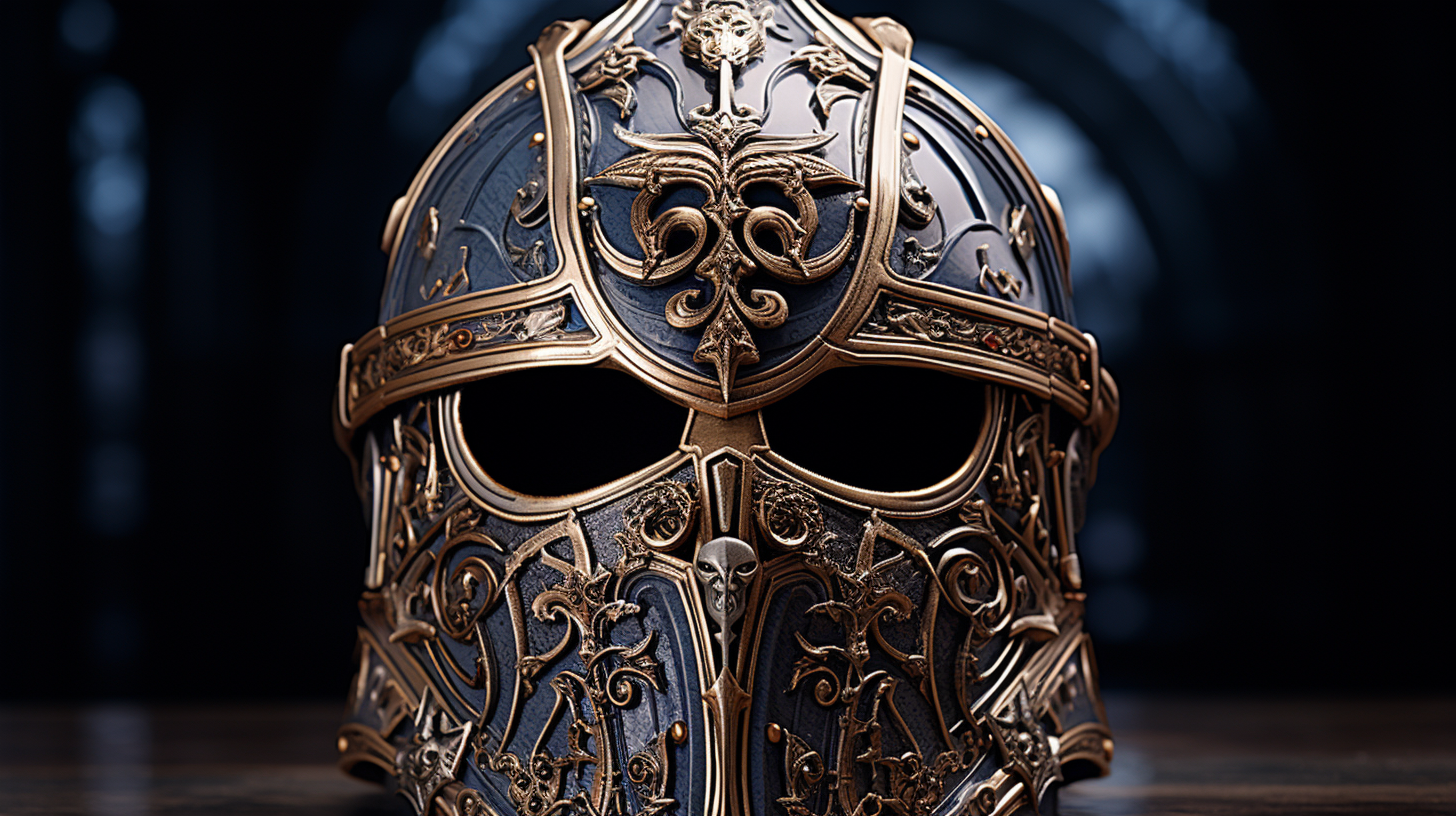
Image: Imagine a visor with a visage of fierce determination, its intricate design conveying a sense of honor and nobility.
Ornate Visors and the “Frog-Mouth” Design
Some knights opted for ornate visors with elaborate decorations, while others favored the “frog-mouth” design—an elongated visor that allowed for greater visibility and air circulation during combat.
In this section, we’ve uncovered the artistry and functionality of the individual components that composed a knight’s suit of armor. These elements were not merely pieces of metal; they were reflections of the knight’s identity, bearing both practicality and a rich cultural significance.
Innovations in Plate Armor Design
As our journey through the world of medieval armor continues, we find ourselves at a crossroads where innovation and craftsmanship converge. The design of plate armor, already a masterpiece in itself, saw continuous improvement and adaptation. In this section, we explore the ingenious innovations that elevated plate armor to new heights of functionality and aesthetics.
Articulated Joints: The Key to Mobility
One of the most significant innovations in plate armor design was the incorporation of articulated joints. These joints were engineering marvels that allowed knights to move with remarkable agility while maintaining their protective coverings.
Placeholder Image: Envision the intricate articulation of armor joints, with rivets and hinges, allowing fluid movement that was once thought impossible in such heavy attire.
Enhancing Flexibility and Maneuverability
The addition of articulated joints to plate armor revolutionized combat for knights. With greater flexibility at the elbows, knees, and hips, they could mount horses, engage in swordplay, and navigate treacherous terrain with ease.
Fluting: Beauty Meets Functionality
Fluting was another innovation that not only enhanced the aesthetic appeal of armor but also had practical advantages. This design feature involved the creation of raised ridges or channels on various pieces of armor.
Placeholder Image: Picture armor adorned with elegant fluting, where the interplay of light and shadow accentuates the knight’s presence.
Reinforcing Strength
Fluting not only added a touch of elegance but also increased the rigidity of armor. The ridges served to strengthen the armor’s structure, making it more resistant to impacts and strikes.
Decorative Embellishments: A Personal Touch
In addition to their protective functions, knights took pride in making their armor a reflection of their individuality. They often adorned their suits with decorative embellishments that ranged from ornate patterns to engravings of personal significance.
Placeholder Image: Imagine armor with intricate engravings, depicting heraldic symbols, mythical creatures, or scenes from chivalric legends.
Heraldic Elegance
Decorative embellishments often included the knight’s personal heraldic symbols, which further solidified their identity on the battlefield. These symbols were intricately integrated into the armor’s design.
Design Adaptations for Different Needs
Innovations in armor design weren’t limited to aesthetics. Knights would often customize their armor for specific purposes. Some suits were tailored for tournaments, while others were optimized for combat on horseback or on foot.
Placeholder Image: Visualize a tournament suit, distinct with its specialized features, designed for jousting and combat displays.
Tournament Armor: Graceful and Functional
Tournament armor was tailored for events that showcased a knight’s skill and precision. It featured additional protection for the wearer, ensuring safety during jousts and other martial contests.
In this section, we’ve explored the remarkable innovations that transformed plate armor into a fusion of form and function. As knights continued to adapt their armor to meet the evolving challenges of combat and competition, they left an indelible mark on the world of fashion and craftsmanship.
Chainmail: A Step Forward
In our journey through the annals of medieval fashion, we now turn our attention to one of the pivotal innovations in knightly attire—the advent of chainmail. A true testament to the ingenuity of medieval armorers, chainmail marked a significant stride forward in the pursuit of both protection and mobility.
Chainmail: Rings of Resilience
Chainmail, as the name suggests, is a type of armor composed of interlocking rings. These rings were meticulously crafted from iron or steel and then skillfully woven together to create a flexible yet robust barrier.
Placeholder Image: Envision a close-up of chainmail, the intricate mesh of rings glistening in the light, ready to protect its wearer.
Flexible Protection
Chainmail provided knights with greater flexibility than earlier forms of armor. The interlinked rings allowed for a range of motion crucial for mounted combat, swordplay, and maneuvering on the battlefield.
A Mesh for All Seasons
One of the advantages of chainmail was its adaptability to different combat scenarios. It could be worn over a padded garment or combined with plate armor, offering varying levels of protection based on the knight’s needs.
The Birth of the Hauberk
The most iconic piece of chainmail armor was the hauberk—a long, sleeveless tunic that covered the torso, arms, and legs. The hauberk became synonymous with the image of the medieval knight.
Placeholder Image: Picture a knight donning a hauberk, the shimmering mesh flowing down to protect nearly every inch of the body.
The Hauberk’s Role in Combat
The hauberk served as an essential protective layer for knights. Worn beneath other armor or clothing, it absorbed the brunt of blows from weapons, reducing the impact on the wearer.
Chainmail Variations: From Head to Toe
Chainmail wasn’t limited to the hauberk alone. Knights adapted this versatile material for various purposes, creating specialized pieces to safeguard different parts of the body.
Placeholder Image: Imagine a knight with a coif, a hood-like piece of chainmail covering the head and neck, providing comprehensive protection.
Coifs and Voiders
To protect the head and neck, knights wore coifs—a hood-like piece of chainmail. Voiders, on the other hand, covered the gaps between armor plates and provided an additional layer of security.
In this section, we’ve uncovered the significance of chainmail in the evolution of knightly attire. From its flexibility and adaptability to the iconic hauberk and specialized variations, chainmail played a vital role in the protection of medieval knights.
The Rise of Plate Armor
In the grand tapestry of knightly attire, one epoch stands out as a pinnacle of protection and artistry—the era of plate armor. With its imposing presence and intricate design, plate armor became the embodiment of knighthood, offering a level of protection and style that left an indelible mark on medieval fashion.
Plate Armor: A Masterpiece of Craftsmanship
Plate armor, often referred to simply as “plate,” represented the culmination of centuries of armor development. It was a testament to the dedication and skill of armorers who transformed knights into walking fortresses.
Placeholder Image: Visualize a knight adorned in a full suit of plate armor, a majestic and imposing figure ready for battle.
Lamellar Inspiration
The concept of interlocking plates, reminiscent of early lamellar armor, served as the foundation for plate armor. However, plate armor took this idea to an entirely new level, with articulated segments covering the entire body.
Precision Crafting
The creation of plate armor required meticulous precision. Armorers used specialized tools to shape, size, and assemble each piece. The result was a suit that fit the knight like a second skin, offering both protection and ease of movement.
The Components of Plate Armor
A full suit of plate armor consisted of various components, each with a specific purpose and design. Let’s explore the key elements that composed these magnificent suits.
Placeholder Image: Envision a detailed illustration showcasing the individual components of plate armor, from the cuirass to the greaves, each piece a work of art in its own right.
Cuirass: Safeguarding the Torso
The cuirass was the central piece of plate armor, encompassing both the breastplate and the backplate. It provided comprehensive protection for the knight’s torso, the heart of their vulnerability.
Pauldrons and Spaulders: Guarding the Shoulders
Pauldrons and spaulders protected the shoulders and upper arms. They were often designed with fluting or other decorative elements, adding both protection and visual appeal.
Greaves and Sabatons: Shielding the Legs and Feet
The lower limbs were safeguarded by greaves, which covered the shins, and sabatons, which protected the feet. These pieces allowed knights to march confidently into battle.
Gauntlets: Hands of Precision
Gauntlets, adorned with articulated fingers, offered the dexterity required for combat. They were both functional and decorative, showcasing the knight’s identity.
Helmets: The Knight’s Visage
Helmets, an integral part of plate armor, were more than just protective headgear. They often featured visors with ornate designs that conveyed a sense of nobility and honor.
In this section, we’ve embarked on a journey into the age of plate armor, exploring its intricate craftsmanship and the individual components that made it a symbol of chivalry. As we continue our quest, we’ll delve deeper into the innovations and adaptations that shaped this remarkable era in knightly attire.
Innovations in Plate Armor Design
As we delve further into the realm of plate armor, we uncover a series of ingenious innovations that transformed these suits of protection into marvels of both function and fashion. These innovations were a testament to human ingenuity, adapting to the ever-evolving needs of knights.
Articulated Joints: Engineering for Mobility
Articulated joints were at the heart of plate armor’s adaptability. They allowed knights to move with unprecedented freedom while maintaining their protective coverings.
Placeholder Image: Picture the inner workings of articulated joints, a symphony of rivets and hinges ensuring fluid movement within the armor.
Enhancing Range of Motion
Articulated joints significantly improved a knight’s ability to perform tasks that required agility, whether on horseback or engaged in close combat. The precision engineering of these joints enabled actions like raising arms, bending knees, and even mounting horses with ease.
Fluting: Aesthetic and Structural Brilliance
Fluting, both an art form and an engineering solution, added a unique dimension to plate armor. This technique involved creating raised ridges or channels on various pieces of armor.
Placeholder Image: Visualize fluting as both a decorative element and a structural reinforcement, the play of light and shadow enhancing the armor’s allure.
Strengthening Armor Structure
Beyond its aesthetic appeal, fluting served to reinforce the structural integrity of plate armor. These ridges distributed the force of impacts more effectively, making the armor more resilient against strikes.
Decorative Embellishments: Personalizing Armor
Knights embraced the opportunity to make their armor a canvas for personal expression. Decorative embellishments, from intricate patterns to meaningful engravings, added both style and substance to their suits.
Placeholder Image: Imagine a knight’s armor adorned with exquisite engravings, telling stories of honor, lineage, and chivalry.
Heraldry and Identity
Decorative embellishments often featured the knight’s heraldic symbols, reinforcing their identity on the battlefield. These symbols were more than ornaments; they were visual declarations of allegiance and valor.
Design Adaptations: Tailoring for Purpose
Knights tailored their armor to suit specific needs. Some suits were designed for tournaments, others for mounted combat or foot soldiers. These adaptations showcased the versatility of plate armor.
Placeholder Image: Visualize a specialized tournament suit, distinct in its features, designed to protect while allowing freedom of movement.
Tournament Armor: Balancing Protection and Mobility
Tournament armor was crafted for knights to display their martial skills. It offered enhanced protection while enabling them to showcase their prowess in jousts and contests of chivalry.
In this section, we’ve unveiled the remarkable innovations that elevated plate armor to its zenith. From articulated joints that granted freedom of movement to fluting that combined beauty with resilience, these innovations were a testament to the creativity and craftsmanship of the era.
The Components of Plate Armor
Our exploration of plate armor continues as we dissect the intricate components that constituted these remarkable suits of protection. Each element played a specific role in safeguarding the knight while contributing to the overall aesthetic splendor of the armor.
Cuirass: The Guardian of the Torso
The cuirass, often regarded as the centerpiece of plate armor, provided comprehensive protection for the knight’s torso. It consisted of two main parts: the breastplate and the backplate.
Placeholder Image: Imagine the imposing cuirass, meticulously designed with overlapping plates, creating a formidable barrier for the knight.
Breastplate: Shielding the Front
The breastplate, crafted from a single piece of metal, was the foremost element of the cuirass. It protected the knight’s chest and abdomen, shielding vital organs from harm.
Backplate: Safeguarding the Rear
Equally crucial was the backplate, which extended from the nape of the neck to the lower back. It ensured that the knight was protected from attacks originating from behind.
Pauldrons and Spaulders: Guardians of the Shoulders
Pauldrons and spaulders played a vital role in protecting the shoulders and upper arms. These components were not only functional but also embellished with decorative elements.
Placeholder Image: Visualize the pauldrons and spaulders, adorned with intricate patterns and fluting, reinforcing the knight’s strength and dignity.
Articulated Plates for Flexibility
To allow freedom of movement, pauldrons and spaulders often featured articulated plates, enabling the knight to raise their arms and wield weapons with ease.
Greaves and Sabatons: Defending the Lower Limbs
The lower limbs, susceptible to attacks, were protected by greaves and sabatons. Greaves covered the shins, while sabatons guarded the feet.
Placeholder Image: Picture the greaves and sabatons, shining with precision craftsmanship, ensuring the knight’s legs were well-guarded.
Adaptation for Mobility
Greaves and sabatons were designed to provide protection without hindering mobility. They allowed knights to march, ride, and engage in combat with confidence.
Gauntlets: Precision in Battle
Gauntlets, often adorned with articulated fingers, allowed knights to maintain dexterity and precision in combat. These essential components protected the hands and wrists.
Placeholder Image: Envision the gauntlets, their intricate finger articulation enabling the knight to wield a sword or lance with finesse.
Functional Beauty
Gauntlets were not only functional but also a canvas for artistic expression. They featured decorative elements, reinforcing the knight’s identity and adding to the overall aesthetic of the armor.
Helmets: The Knight’s Visage
A knight’s helmet was not merely protective; it often bore a visor with elaborate designs. Helmets played a crucial role in safeguarding the head while conveying the knight’s character.
Placeholder Image: Imagine a knight’s helmet, the visor adorned with intricate patterns and a visage that exuded determination and honor.
Visor Variations
Helmets came in various forms, each with unique visor designs. Some knights preferred the “frog-mouth” visor for improved visibility, while others opted for more ornate variations.
In this section, we’ve explored the individual components of plate armor, each a masterpiece of craftsmanship and design. These elements came together to create suits of protection that were both functional and visually captivating.
Armor Materials and Their Advancements
Our journey through the evolution of knightly attire brings us to a critical juncture—the materials that shaped the very essence of plate armor. The choice of materials determined not only the armor’s protective capabilities but also its weight, durability, and overall effectiveness on the battlefield.
Steel: The Backbone of Plate Armor
Steel, with its unparalleled strength and durability, was the quintessential material for plate armor. The advancements in metallurgy during the medieval period played a pivotal role in armor development.
Placeholder Image: Visualize a cross-section of steel armor, showcasing its layered construction and the quality of the metal, essential for protection.
Forging Excellence
Armorers meticulously forged steel into thin plates, ensuring both strength and flexibility. The process involved heating, hammering, and quenching to achieve the desired properties.
Layered Protection
Plate armor was often constructed in multiple layers, with each layer offering a unique form of protection. Steel plates were carefully arranged to maximize coverage while maintaining mobility.
Other Materials: Reinforcements and Ornamentation
While steel was the primary material, plate armor often incorporated other substances for various purposes, from reinforcing vulnerable areas to adding decorative flair.
Placeholder Image: Envision a knight’s armor adorned with decorative elements, showcasing the fusion of steel with materials like leather and cloth.
Leather and Cloth
Leather and cloth were used as padding and lining within the armor, providing comfort to the wearer and absorbing the shock of impacts.
Ornamentation and Gilding
To elevate the aesthetic appeal of the armor, knights often incorporated gilding, inlays, and embossing. These ornate elements not only added to the armor’s beauty but also served as symbols of status and honor.
Advancements in Armor Materials
As the medieval era progressed, armorers continually sought ways to improve armor materials. Innovations in steel production and the introduction of alloys led to even more robust and adaptable armor.
Placeholder Image: Imagine a side-by-side comparison of early and advanced plate armor materials, highlighting the evolution of metallurgical techniques.
Refining Steel Production
Medieval armorers experimented with various steel alloys and refining techniques, resulting in armor that offered enhanced protection without excessive weight.
Tempering and Heat Treatment
The process of tempering and heat treatment became integral in shaping armor materials. These methods improved the metal’s hardness and resilience, ensuring it could withstand the rigors of combat.
In this section, we’ve explored the critical role of materials in the development of plate armor. Steel, with its strength and adaptability, remained the cornerstone of these iconic suits. The integration of other materials and continuous advancements in metallurgy further elevated the art of armor crafting.
The Legacy of Plate Armor
Our journey through the annals of knightly attire culminates in a reflection on the enduring legacy of plate armor. While it has evolved and adapted over the centuries, the impact of these iconic suits on fashion, culture, and even warfare remains profound.
Fashion Echoes: Influence Beyond Eras
Plate armor’s influence transcended its time, leaving an indelible mark on the world of fashion. Even today, echoes of its design can be seen in contemporary clothing and accessories.
Placeholder Image: Visualize a modern fashion runway where elements of plate armor are incorporated into avant-garde designs, showcasing the enduring inspiration it provides.
Armor as Inspiration
Fashion designers have drawn inspiration from the structured lines, ornate patterns, and bold silhouettes of plate armor. Elements like metallic accents, rivets, and layered textures pay homage to the knights of old.
Cultural Significance: Chivalry and Heroism
Plate armor was not just protective gear; it embodied the ideals of chivalry, heroism, and honor. Knights clad in gleaming suits became symbols of nobility and valor.
Placeholder Image: Imagine a medieval tapestry depicting a knight in shining armor, mounted on a noble steed, a beacon of courage and nobility.
Chivalric Code
The chivalric code, with its emphasis on honor, courage, and loyalty, was epitomized by knights who wore plate armor. They served as exemplars of these ideals, inspiring others to follow suit.
Warfare and Evolution: Impact on Battlefields
Plate armor’s introduction revolutionized medieval warfare. Its ability to withstand blows and protect vital areas of the body altered the dynamics of battle.
Placeholder Image: Envision a battlefield scene where knights clad in plate armor stand firm amidst the chaos, a testament to the armor’s protective qualities.
Tactical Advantages
The resilience of plate armor gave knights a significant advantage on the battlefield. They could engage in combat with confidence, knowing their armor would shield them from harm.
Collectors and Museums: Preserving History
Today, plate armor is treasured by collectors and museums worldwide. These artifacts serve as windows into the past, preserving the craftsmanship and artistry of a bygone era.
Placeholder Image: Picture a dimly lit museum exhibit, where a suit of plate armor stands as a sentinel of history, inviting visitors to step back in time.
Educational Tools
Museums provide valuable insights into the evolution of armor and the lives of knights. They educate the public about the rich history and cultural significance of these suits.
In this final section, we’ve explored the enduring legacy of plate armor, from its influence on fashion to its embodiment of chivalric ideals. As we conclude our journey through the ages of knightly attire, we leave behind a world forever touched by the resplendent armor of knights.
Conclusion: Unveiling the Enigma of Knightly Attire
In our enthralling expedition through the annals of history, we’ve embarked on a captivating journey, unearthing the mysteries, splendor, and profound impact of knightly attire. From the clinking chainmail of medieval warriors to the gleaming suits of plate armor, each era’s attire has woven a unique tapestry in the rich fabric of history.
A Tapestry Woven in Steel and Silk
Our voyage began with the rugged resilience of chainmail, where warriors braved the chaos of battle with interlocking rings of steel. As we ventured deeper into the past, the allure of plate armor beckoned, showcasing a fusion of artistry and defense that was nothing short of awe-inspiring.
Placeholder Image: Envision a tapestry where knights clad in chainmail and plate armor stand side by side, their attire symbolizing the evolution of an era.
Resilience Meets Aesthetics
Chainmail, with its intricate interplay of rings, represented a testament to craftsmanship and resourcefulness. Meanwhile, the opulent suits of plate armor displayed not only the pinnacle of protection but also a canvas for artistic expression.
Cultural Echoes and Impact
Beyond the battlefield, the attire of knights resonated through culture, fashion, and chivalric ideals. Fashionistas drew inspiration from the structured lines and bold silhouettes of armor, while knights embodied the chivalric code, standing as paragons of honor and valor.
Placeholder Image: Imagine a medieval banquet hall where knights in resplendent armor mingle with nobles and artists, a tableau of the era’s cultural fusion.
Fashion’s Timeless Reverberations
Even in contemporary fashion, echoes of plate armor resound, reminding us of the enduring allure of knightly attire. Its legacy endures not only as a symbol of protection but as a source of inspiration in the ever-evolving world of style.
Battlefield Prowess and Tactical Evolution
Plate armor’s introduction forever altered the dynamics of warfare. Knights clad in these formidable suits possessed an unmatched advantage on the battlefield, turning the tide of history.
Placeholder Image: Visualize a reenactment of a medieval battle, where knights in plate armor charge forward, their formidable presence reshaping the course of the conflict.
Shields of Iron and Valor
The resilience of plate armor transformed knights into living legends, their presence on the battlefield striking fear into the hearts of their adversaries. They were not just protectors of their lands but champions of an era.
Preserving History’s Masterpieces
Today, plate armor stands as a testament to the craftsmanship and artistry of a bygone era. Museums and collectors meticulously safeguard these historical masterpieces, allowing us to step back in time and relive the splendor of knights.
Placeholder Image: Picture an armored knight’s gauntlet, juxtaposed with a skilled blacksmith’s tools, highlighting the artistry and precision that went into armor crafting.
An Ongoing Journey
As we conclude our exploration, we leave behind a world forever touched by the resplendent armor of knights. Their attire, from humble chainmail to grand plate armor, remains an enigma, a testament to human ingenuity, resilience, and the timeless allure of knightly attire.



